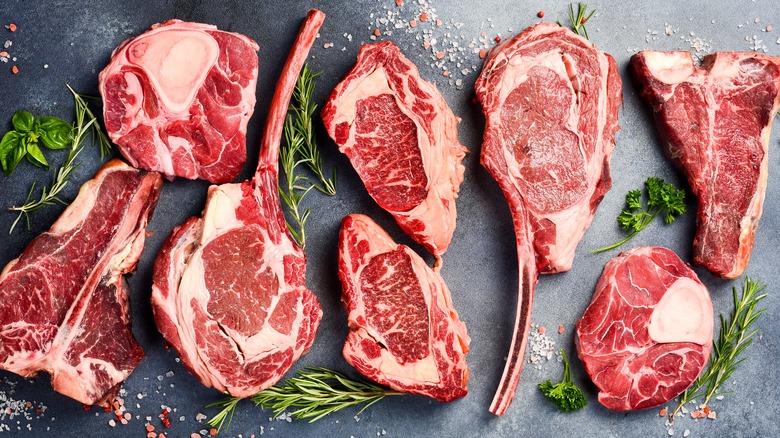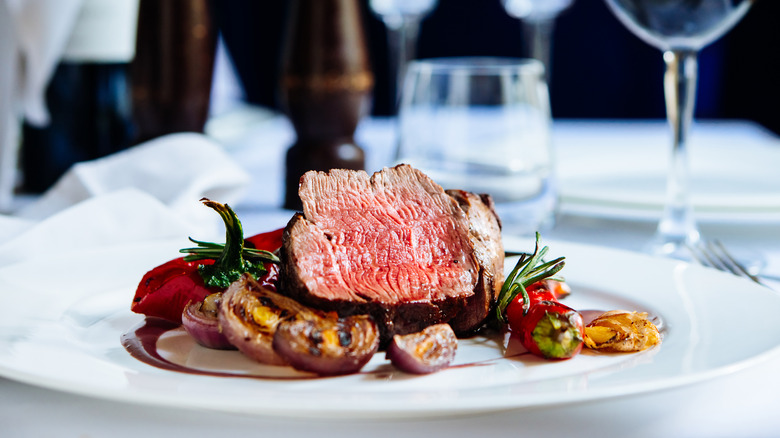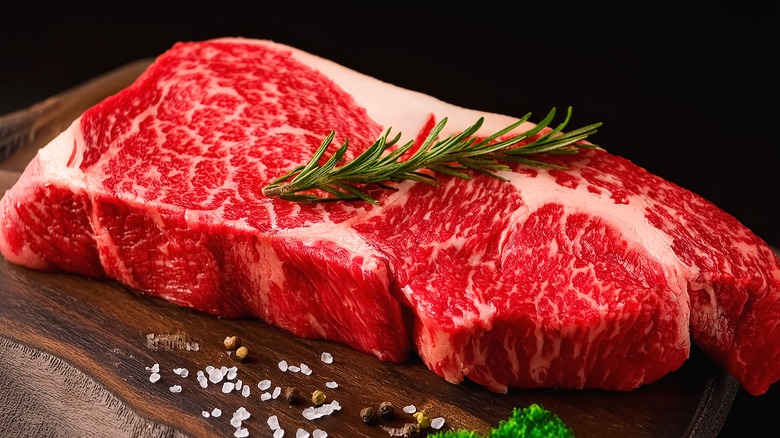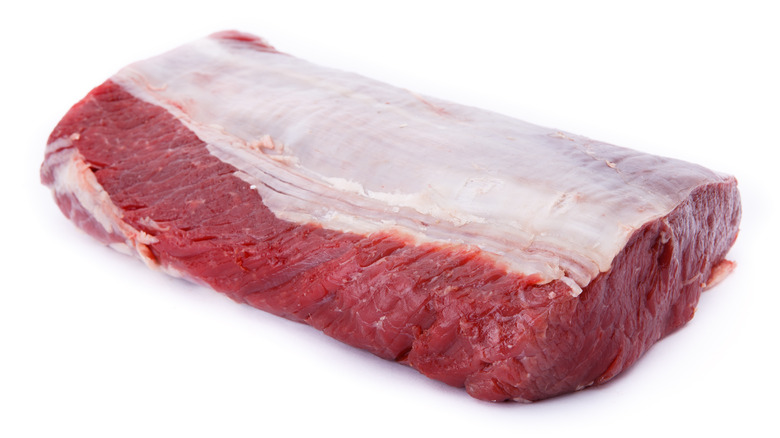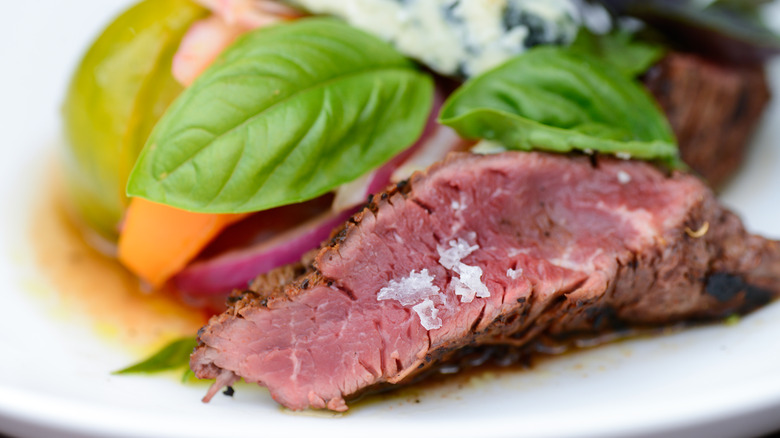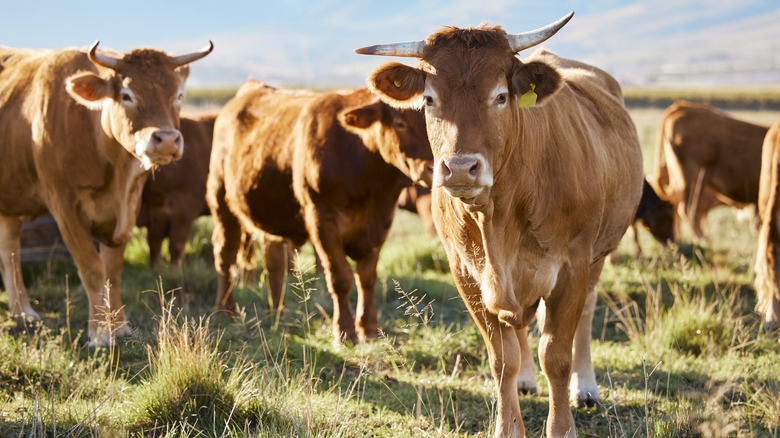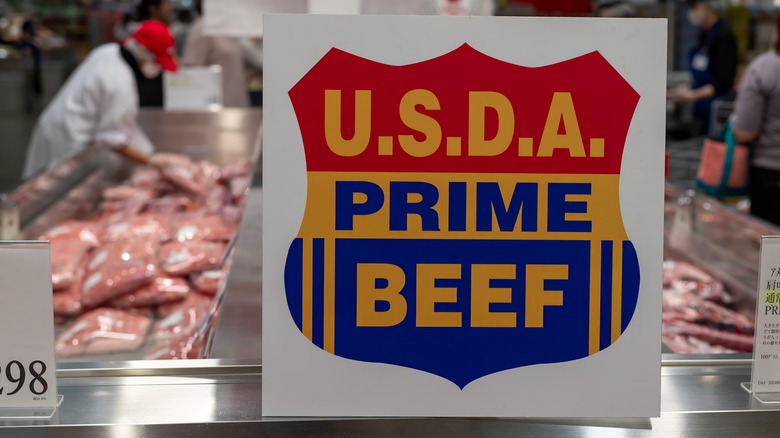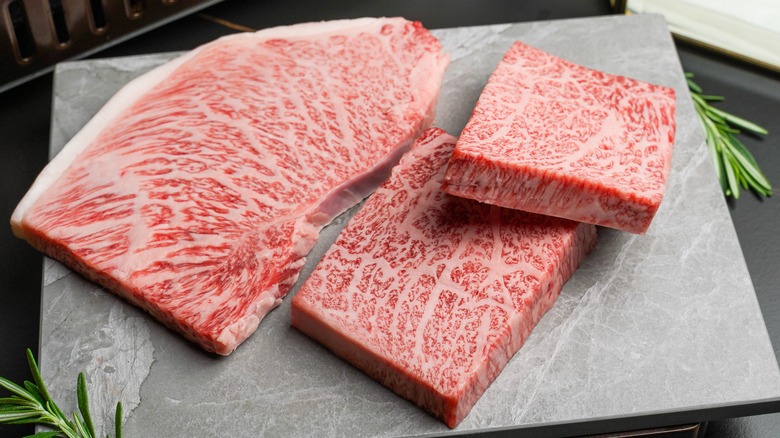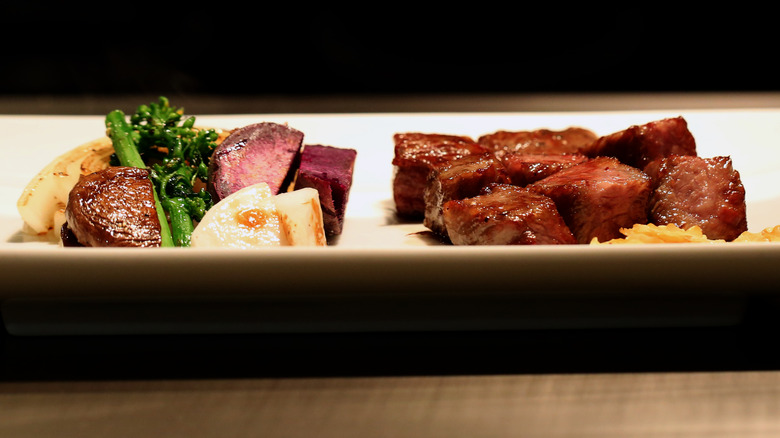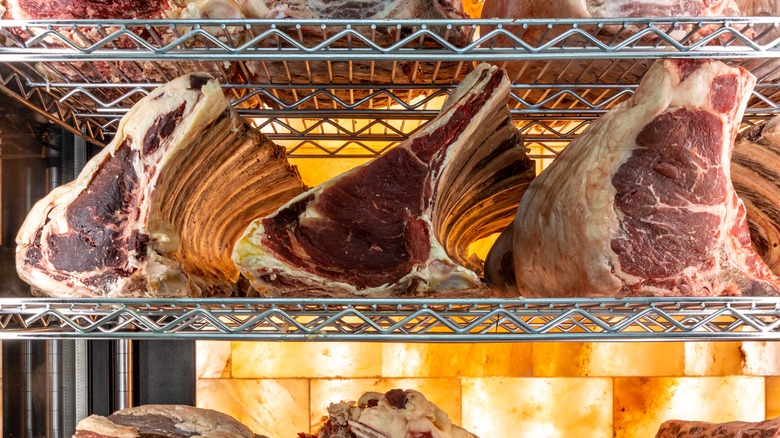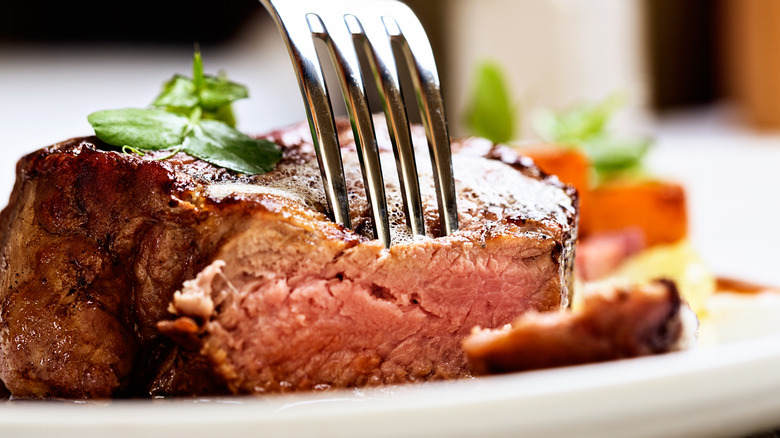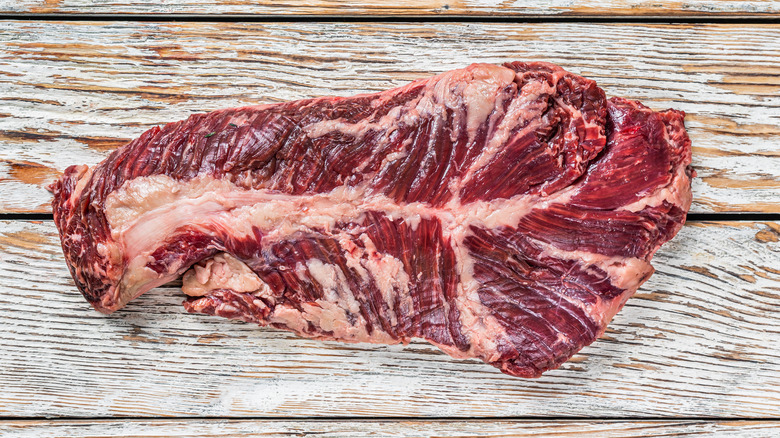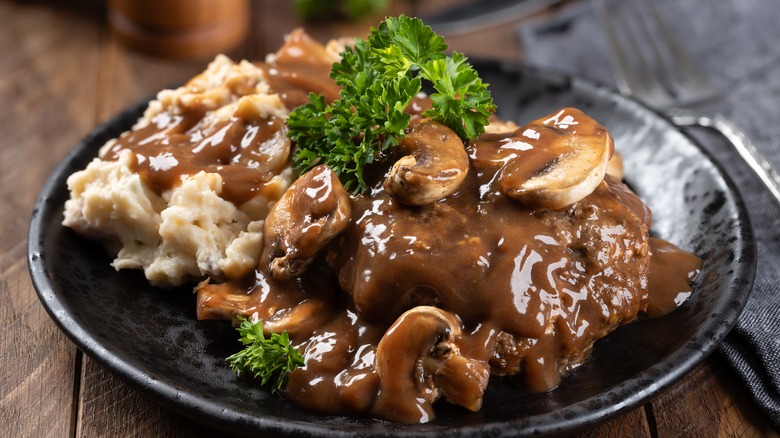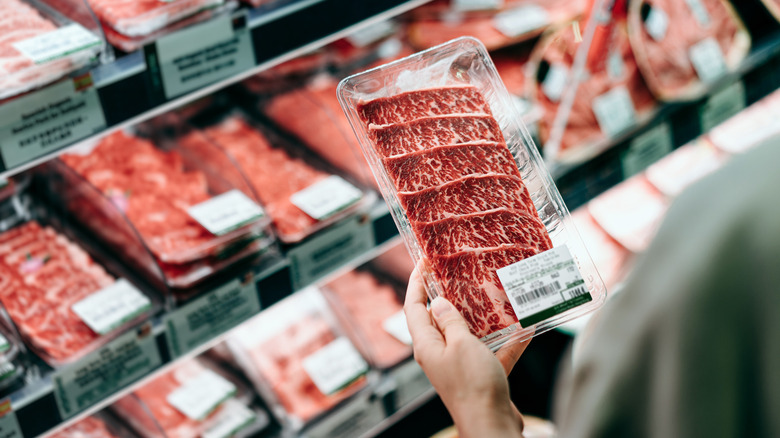Cheap Vs Expensive Cuts Of Steak: How To Spot (And Taste) The Difference
We may receive a commission on purchases made from links.
This one goes out to those who answer the call of the wild, who grab life by the teeth — and who sometimes order delivery without moving from the sofa. No matter how you slice it it, prime beef is all about that tender, juicy, mind-bending bite. Curious about which cut is the medium-rarest of them all (and which are not-so-well-done)? We tapped a pro to help.
Michelin-starred restaurant G.M. and hospitality expert Melissa Foster shares everything she knows about selecting the finest cuts, thanks to her nearly two decades in the industry (don't worry, she's also down for a little A.1. sauce — she's a woman for the people). Watch American cows battle it out against Japanese wagyu, while dry-aged Kansas strip hits all the right notes, and Salisbury steak brings retro comfort to modern times. From sky-high beef standards to the color that comes from happy cows; the most flavorful veining; a few tips on cooking — and what the heck is silverskin? — we're going nose-to-tail to help you nail the perfect cut.
You don't need to name-drop to get a great steak
Fancy steaks hog the cameras. Ever heard of filet mignon or cote de boeuf? But the actual best steak comes down to your unique tastes. "This can be a little subjective, but yes, I do think the quality of beef does come into play," Melissa Foster admits. "I don't really like to say one cut is better than another, because that falls into personal preference territory." We agree. But also we want names.
Compelled to share her best-loved cuts, Foster went with: "Tomahawk — where the full rib bone is still attached, dry-aged porterhouse, dry-aged cowboy cut ribeye, [and] wagyu New York strip." You might also find her sampling another highly-prized morsel. "A5 grade wagyu," she says. "This isn't usually served as a big steak, it's more like bites/slices or max 4-ounce portions. It's so fatty and rich, but so delicious." On the wagyu scale from 1 to 5, an A5 grade is Best In Show at a dog show for cows.
Of course, there are less scintillating cuts out there. Pressed to reveal the steaks she might avoid, Foster lists, "London broil, top round, flank steak... But these you'd probably never see on a menu." Still, she throws these cuts a bone, adding, "For cooking at home, they're good for stews and [they're] way cheaper cuts."
Marbling is just fat which amps up the flavor
There's a lot of buzz around marbling — or the white veining in the muscle tissue of the steak (it gets its name from marble rock patterning). Gorgeously flecked marbling consistently jacks up the price tag, but it also tastes like a million bucks.
"Marbling is all of the delicious fat layered into the muscle fibers," shares Melissa Foster. "It's what adds a significant amount of flavor into cuts of meat. It is also a major factor of USDA grading." You'll see delicate webs of fat running through higher-end steaks like Kobe beef and wagyu, contrasting the thicker and less evenly-distributed fat in less-expensive cuts. High fashion-like marbling keeps the meat tender and juicy as the fat melts while it cooks. But it's not the only thing that packs a punch. "The bigger cuts I always prefer cooked over a wood-fired grill — it just adds and helps develop a great crust and added flavor," Foster explains. She also redefines stick-to-your-ribs eating, adding, "Anything bone-in will also add flavor."
Don't cringe at the silverskin connective tissue
There's marbled fat, and then there are those rubbery layers that are impossible to chew. But that connective tissue — "Sometimes also called 'silverskin' because it can have a silvery sheen to it," notes Melissa Foster — cranks up the flavor when you cook it low and slow.
"Sometimes you see more connective tissue in lower grades of beef — but it honestly just depends on the cut," explains Foster. "Shanks, osso buco, and short ribs all have a considerable amount of connective tissue, and when you cook that at a lower temperature for a long period of time in a liquid, the tissue breaks down leaving you with a really tender and juicy piece of meat as the result." Even more affordable top round turns out tender and juicy with a slower cook. While osso buco might be best left to the chef de cuisine, save every last bit of those cooking juices if you're going scratch-made. "Ah, and the braising liquid — it's like liquid gold and an amazing, flavorful base for making sauces easily at home," Foster says. We can already taste the au jus.
For lean game meat, you might need extra kitchen chops
Not all steaks come from cattle. Even though hunting down your dinner in the wild can help you connect to your food source, these super-lean, earthier-tasting cuts often require a little more care in the kitchen. Even if you buy them from the store.
Sharing a few favorites that might appear in the meat section, Melissa Foster taps grassland and forest-dwelling creatures for a tasty dish. "Bison or venison are great," she says, with special mentions for duck and squab (young pigeon). "Usually wild game is A LOT leaner, so [it's] less forgiving when cooking," she advises."I think cooking game requires a higher skill level than most average home cooks and you simply don't come across it quite as often unless you're in smaller towns." City-dweller or outback survivalist, no matter how you slice it (or cook it), just remember to rest your steak to seal in the flavor.
Happy cows mean top-quality steaks
There's a clear price difference between conventional beef versus a grass-fed, organic, ethically-farmed, heritage breed Red Angus named Steve who's fed by hand and sleeps in Egyptian cotton sheets. So are happy cows really worth the higher price tag? Signs point to yes.
"[The] flavor of the beef depends a lot on their diet and environment," Melissa Foster notes. "You can equate it to cage-free or pasture-raised chickens that lay eggs. Ever notice how much darker and more nutrient-rich the yolk is on a pasture-raised chicken egg vs. even a cage-free? Same goes for beef, even though it may be a bit harder to visually see the difference." While Foster says the "slightly gamier" flavor of grass-fed beef might be a little harder to distinguish unless you've refined your steak-eatin' palate, she offers, "You can definitely see the difference in [the] color of the fat and meat on a grass-fed cow — the fat is more yellow, the meat tends to be a bit darker in color."
Make the grade with USDA prime or choice cuts
Here's where we separate the bulls from the rest of the herd. Or, the higher-end USDA Prime from the, uh, USDA utility beef category that's reserved for... other things. Since steaks vary widely in fat content, this standardized grading system for American beef helps us sort it all out. Long story short, you'll get the best quality with USDA prime or choice cuts.
"Prime is the highest grade and usually has the best marbling (FAT = FLAVOR). I try to buy prime if I am having that meat in a simply cooked format — for example, simply grilled, broiled, or cooked in cast iron on the stovetop," advises Melissa Foster. When the steak flies solo as the star of the show, she goes for "Ribeyes, New York strips, and sometimes filet."
But if the beef's tucked into a stew, you don't need to go all out on the best cut. "If you are braising, or serving it with a really flavorful sauce or marinade, the flavor of the beef won't be a stand alone, so you can kinda cheat the system and get away with a lower grade of beef and still have a really delicious outcome," says Foster. "I try to stick with choice or prime depending on the cooking application."
American wagyu deals Japanese wagyu stiff competition
Japanese wagyu gets all the glory, but American wagyu throws down hard in this competitive category. "Wagyu refers to the breed of cow," Melissa Foster shares of this exquisite stock. "And yes, 100% it's usually worth the prices — especially if you are cooking it at home."
Like fine wine, Japanese wagyu cattle are raised to the strict standards of each particular region in Japan, then graded as A, B or C (A being the highest weight ratio of meat per animal) and 1 through 5 on marbling, color, texture, and firmness. On this scale, A5 wagyu is the G.O.A.T.
But you don't have to book a trip to Honshu, Japan to taste a marbly steak from a prefecture. Ranchers in the U.S. raise wagyu that goes head-to-head with the Japanese variety. Foster explains, "Snake River Farms in Idaho is a great example, there's also great wagyu coming from the Midwest, and even Australia." You can also nab a butcher to pack up a wagyu steak just for you. She adds, "One of my personal favorites is Flannery Beef — they have an outstanding selection that you can order right to your door."
When in Japan, Kobe beef is your top wagyu
Now that you've gone full wagyu, nail the landing with one of the most prized cows of the Japanese herd: Kobe beef. "Kobe beef is wagyu that comes from the Kobe region of Japan," notes Melissa Foster. (Kind of like Champagne from, well, Champagne, France.) "Kobe is just outside of Osaka, like a 20 to 30-minute train ride," she says.
Of the more than 200 types of wagyu raised in various regions of Japan, Kobe beef lands in the top three most esteemed bloodlines, along with the Matsusaka Ushi and Ohmi Beef brands. "There is no shortage of wagyu in this region," Foster shares, having traveled throughout the country. "I was there earlier in the year and basically there were endless restaurant options for wagyu, and so much cheaper than here in the States." Maybe we will be booking that trip to Japan for a little (ahem) steak-cation.
Dry-aged steak is worth the ultra-luxe price point
Dry-aged steak is going to cost a little more, but it'll change your life starting with your taste buds. Be it a bone-in strip, or a hefty ribeye, this aging process works best on cuts with bone and fat to protect the meat. "If I could afford to eat dry-aged beef as my only option for steaks I would," says Melissa Foster. Where do we sign up for that?
While wet-aged steak is the bright red stuff you typically see at the store, dry-aged steak makes contact with air, taking on a muted hue as it forms an exterior crust. The higher price tag has everything to do with the meat shrinking in size as it loses some of its moisture (and simultaneously shoots to the moon, in flavor), plus the longer time it takes to actually age. "One of my absolute favorite steaks of all time is Flannery Beef's Dry-Aged Kansas City Strip. I'll order some to have at home from time to time," Foster adds.
The most expensive steak isn't always the tastiest
Beauty — and flavor — is in the eye of the beholder. And that goes double for the spendiest steak on the menu. Just because a cut's listed at the top of the heap doesn't mean it's always your best bet.
"The Kansas City strip I mentioned... that steak is not for everyone. It's tender but it also has some chewy texture to it and it's crazy flavorful," Melissa Foster explains of the subjective nature of anyone's favorite steak. "Some people love a filet... it's tender, it's a bit leaner — nothing wrong with that." She assures you to confidently order the cut of your dreams, even if it's not the fanciest option on tap. Foster adds, "On most menus I've seen recently, New York strips and ribeyes are a bit pricier. Filets are kind of in the middle, and cheaper cuts like flat iron or hanger are the most economical."
Don't sleep on the underrated hanger steak
Okay, forget everything we just said about your favorite cut. If you're mentally scrolling through your options, keep a hanger steak tucked in that Rolodex. It's rare to find it on a menu, but that's because this "butcher steak" is one of the industry's best-kept secrets.
"I love hanger steaks. I think it's such an underrated cut and you get so much bang for your buck," Melissa Foster shares. "The texture is like a cross between a skirt steak and a tenderloin but with the flavor of a ribeye." Okay, so, loose grain and tender texture with big, bold, buttery flavor? Have we reached beef-enlightenment? The reason hanger steak appears elusive seems to be because it's so good, no one wants to share it (not even your butcher). A cow yields only one hanger steak, so the demand for this prime cut is real. "Hanger can be tough to come across unless you've got access to a good butcher," Foster admits. "Every now and then I see it at Ralphs, but again, usually I order it from Flannery online."
Salisbury steak makes a comforting meal out of humble scraps
Salisbury steak might sound like 1950s food, but it still pops up on steakhouse menus today. Of course, it's not technically a steak. "I have to admit, I don't think I've ever had it," reveals Melissa Foster, adding, "I feel like it was something I always associated with those T.V. dinners our parents and grandparents grew up on." T.V. dinners sure went out of style, but this ground beef banger did not.
Salisbury steak is just ground chuck shaped into a "steak" and most-likely smothered in mushroom sauce. And if you were a scrappy Civil War soldier in the 1800s, the inventor of this hearty meal, Dr. James Henry Salisbury, was your hero. Debuting as maybe the most affordable steak of all time, Salisbury steak caught on in American households and has somehow survived almost 200 years as its same old self. It's one of those comfort foods that's designed to warm your soul, like spaghetti and meatballs, or mac and cheese. You can make it at home, but the question remains: Is it still Salisbury steak if you mix in a little ground wagyu? We say yes.
Shop for steak that's been vetted and standardized
It doesn't matter whether you're grabbing a short loin from a heritage farm, or scouring the meat case at Costco. All you need are a few tips on choosing the perfect steak from the supermarket. And it all begins with the USDA label smack dab in front of your eyes.
"If you are buying steak at a store, the USDA grade will always be present. If there is no grade that could be a red flag — it has not gone through any type of vetting or inspection process to ensure the quality or food safety standards have been met," Melissa Foster shares. But you don't have to hit up a high-end shop to feel good about your purchase. "Costco has a great selection of beef... I like going to Asian grocery chains as well, they usually have a pretty good selection, and more options you wouldn't necessarily find at, like, a Ralphs or Whole Foods." She recommends the Japanese Mitsuwa Marketplace chain for its wagyu, and 99 Ranch Market for everything from beef tongue to oxtail. She also offers a few shops for when you're going all-out. "If you are really looking for quality cuts I cannot recommend Flannery Beef enough. You can also purchase direct from Snake River Farms online as well," she says. "Both Flannery and SRF also have a great pork selection too."
Treat yourself to a full-service steakhouse experience
You've graduated from Steak University and now it's time to celebrate — while someone else does the cooking. We can all pan-fry a simple steak at home. But why not get the star treatment at a bona fide steakhouse.
Having launched Michelin-starred restaurants in Chicago and Los Angeles, Melissa Foster knows how to rock a night out. "It's gotta start with some sort of seafood tower/raw bar situation (oysters, shrimp cocktail, lobster or crab...)," she shares, cluing us into the essentials. "I love classic steakhouse sides, too — creamed spinach, mashed potatoes. Charred broccolini with a squeeze of lemon makes for a great healthier side... I also love the roasted mushrooms you see on most steakhouse menus now finished with, like, sherry or miso butter." While she'd choose a high-end, dry-aged Kansas City strip, she could go high or low on the accoutrements, adding, "Classic steak sauce (like A.1. style)... I also really like a good nub of black truffle butter to finish a steak... Béarnaise is also so good on a steak." A seasoned chef herself, Foster admits that top-of-the-line steakhouse service is worth the cash for a special occasion. "Even though I can make a lot of this stuff at home for way less, it is nice to treat yourself to the full on steakhouse/service experience every now and then." For the best cut of steak in the house, we don't mind if we do.

